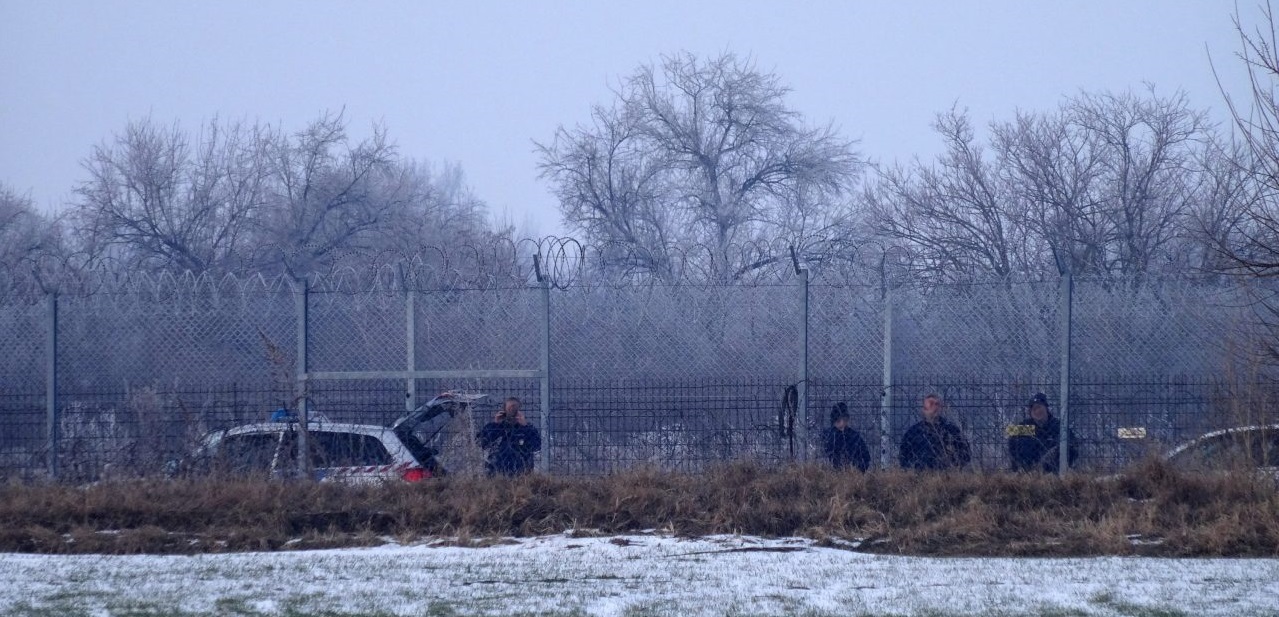The Hungarian border fence, installed on the EU’s external border with Serbia (Source:Rigardu)
Translations:Español, Français & Deutsch.
In March, the Border Violence Monitoring Network (BVMN) published its 1000th testimony, marking a sad landmark. The case, documenting a pushback from Greece to Turkey, adds to the online archive collated by the network, bearing witness to over four years of systemic violence against people-on-the-move at borders in the Balkans. Beginning with reports of pushbacks from Hungary in January 2017, after the formal closure of the humanitarian corridor, the database charts these violations to the present day, visualising the spread of pushbacks across the EU external border. Each entry on the database accounts for a single pushback incident, but these cases often affect transit groups of over 50 persons. Therefore the thousand testimonies relate the experience of over 15,000 people, exposing the high levels of violence and abuse they face, which amount in many cases to torture. We look back here at the primary findings from this huge body of evidence and describe how BVMN has been monitoring these trends.
Calling out border violence
BVMN is a horizontal network of organisations active from Istanbul to the Italian-Slovenian border. The network includes No Name Kitchen, Rigardu, Are You Syrious, Mobile Info Team, Disinfaux Collective, Josoor, ports Sarajevo, InfoKolpa, Centre for Peace Studies, Mare Liberum, IPSIA, Collective Aid and Fresh Response, and other grassroots organizations and collectives in the region. Volunteers from these various member groups have been contributing to a shared online database, which brings together first-hand accounts of pushbacks. These testimonies are gathered by reporters in the field, who take oral interviews with transit communities – leveraging the close social contact developed by the solidarity structures which compose BVMN.
BVMN started in northern Serbia, with a number of different projects in the border area that were documenting violent collective expulsions near Šid and Subotica. Today, the network works in six different countries using a standardised reporting methodology to collect data on pushbacks. Since its inception, BVMN has sought to elevate voices from the ground and share lived experiences of border violence with political stakeholders and publics across Europe. Over the past four years, this evidence has swelled, with the retrenchment of deterrence policies at land and sea borders.
“When we founded the network, we had the goal of collect existing evidence about pushbacks and police violence on the spot in order to gain more publicity around these illegal human rights violations. Even then, in 2017, we had a shockingly high number of these cases. We had hoped that this collection of evidence would finally hold those involved accountable! The publication of the thousandth case, now over four years later, shows the sad reality of this hope. Human rights violations are still systematically condoned on a daily basis in the EU. Behind every number there are people whose rights are violated and who have to experience the EU’s border policy in a brutal way – every day!”
Johanna Degering
Field Reporter, Rigardu
Behind the statistics
As stark as these findings are, to understand the way pushbacks have become an institutionalised part of EU border policing, we need to also see them in tandem with the geo-location data gathered by the network. Across the thousand testimonies, violence against people-on-the-move has been mirrored by multiple border authorities, proving that pushbacks are an institutionalised tool, rather than simply individual acts of violence. Particularly telling, are the similarities between the early cases recorded at the Serbian-Hungarian border by BVMN, and the testimonies that have since populated the database from all across the Balkans. This harmonisation of practice is no surprise when considering the ammount of bilateral police trainings, information sharing, joint surveillance, and involvement of trans-national bodies like Frontex at these borders. Under these conditions, the last four years has seen disturbing levels of violence, with officers carrying out physical assaults, threats with firearms and expelling transit groups en masse – in direct contravention of national and international law.
When many of the member organisations were starting their grassroots initiatives to support people transitting the Balkans, it was almost unimaginable to think we’d be witnessing jarring human rights abuses in the same locations where we were welcoming people with open arms during 2015 and 2016. It was even more unimaginable that the atrocities would be perpetrated by the same police officers who were there at that time, helping to distribute humanitarian aid and even posting photos of themselves with children on social media, proudly smiling at the camera. These people didn’t change much, but their orders did. To speak about individual perpetrators would be too simple: we must also seek accountability where the decisions are made. The authorities who decided to render movement illegal by closing the humanitarian corridor of the Balkan Route in March 2016 are responsible for subsequent profiteering of smuggler chains, for deaths at the border areas, for humanitarian catastrophes in the camps and for pushbacks that are still happening daily, with alarming impunity and with an almost complete lack of independent monitoring mechanisms.
“Our goal is to end the impunity by continuously bringing evidence to the relevant stakeholders on national, EU and UN level. This is making decision makers nervous and they’re responding by trying to criminalise our work. But we are determined to continue monitoring and reporting about human rights abuses in the border areas until those responsible for ordering and executing violations are brought to justice. This is our duty towards numerous people-on-the-move who decided to share their experiences with us. One testimony is easy to ignore. A hundred – a bit harder. What about a thousand?”
Milena Zajović
President of Are You Syrious & Head of advocacy at BVMN
Unmasking perpetrators
While the network’s initial work was primarily focused on testimony collection, an important development of ours in the last years has been linking these testimonies to investigative work with the intention of unmasking the perpetrators of this violence. This was exemplified through our release of some of the first video evidence of Croatian pushbacks caught on camera, near Lohovo in Bosnia-Herzegovina.
In the last year especially, we have developed further links between field open source documentation within BVMNs work on push backs. In August, BVMN-member Josoor helped develop an investigation on push backs in Aegean sea which cross utilized witness testimony with video footage which we geolocated with publicly accessible satellite imagery. The lessons learned from this investigation were later applied in our landmark video investigation, released in November 2020, showing the first footage of a violent pushback from Croatia carried out by masked men. Looking ahead, BVMN plans to continue to explore linkages between field based testimony collect and open source investigative techniques in the pursuit of unmasking these perpetrators.
“Looking back on it now, it’s astounding how the pushback tactics that we witnessed occurring in Serbia in 2017 have become such a shared characteristic of movement along the Balkan Route four years later. Back then, when we established the Border Violence Monitoring Network, we were just a group of small organizations focused on pushbacks from Croatia and Hungary to Serbia. While in many ways we are still just a small group of organizations, our numbers have grown considerably along with the number of borders that we collect testimonies on. I think our network has changed considerably over the years, and in the process the lessons we have learned along the way have been priceless.”
Jack Sapoch
Border Violence Reporting Coordinator, No Name Kitchen
Holding to account
As BVMN has grown, it has played an increasing role at national and EU level in calling out the perpetration of pushbacks and their systematisation across EU borders. The majority of the 1000 testimonies enclosed in the BVMN database were recently submitted to the European Parliament as a two-volume dossier. This “Black Book of Pushbacks” once again brought to the fore hard evidence of extreme rights violations by member states and EU Agencies, demanding substantive action and an end to the violence being meted out at borders. With pressing policy developments on asylum and migration, the role of Frontex within EU border management and the deficit in independent monitoring mechanisms, BVMN and its members continue to inform these debates with critical field data and constructive proposals – based on the principles of safe passage and an end to violence.
Forging accountability has also been at the forefront of recent legal advocacy by the network. BVMN has been supporting both an applicant in Slovenia via member Info Kolpa, and a case in Italy led by Italian legal association ASGI. Alongside the quantitative data collection, these targeted evidentiary submissions illustrate the diversity of tactics that BVMN supports in bringing the perpetrators of pushbacks to justice. Furthermore, alongside these actions against the rising use of chain pushbacks, network member Centre for Peace Studies in Croatia has also launched several criminal complaints related to pushbacks, while Mobile Info Team and Josoor have been active in addressing Frontex with Letters of Concern and scrutinising their deployments in Greece. Within the last year, Are You Syrious has also taken a lead on developing a new line of UN submissions for the network, bringing the issue of pushbacks to new target audiences.
The Black Book of Pushbacks published in collaboration with The Left in the European Parliament (Source:GUE/NGL)
Network member Info Kolpa presenting the book to the Slovenian Ombudsperson (Source:Info Kolpa)
Stories, not figures
BVMN will report and denounce violence against people-on-the-move until it is ended. Rooted in the principle of solidarity, members in the network will continue to work alongside transit communities, listen to their experiences, and join with the many other critical voices across the Balkans who are challenging violent border regimes. Beyond the quantitative data, which surpasses itself year on year with more disturbing levels of torture and abuse, the cases told in the BVMN shared database represent people’s lived experience of these precarious routes. One thousand testimonies are therefore hard to put into perspective. It refers to the collective trauma of thousands of individual persons each with their own unique motivations, emotions, and dreams irreparably affected by Europe’s borders.

